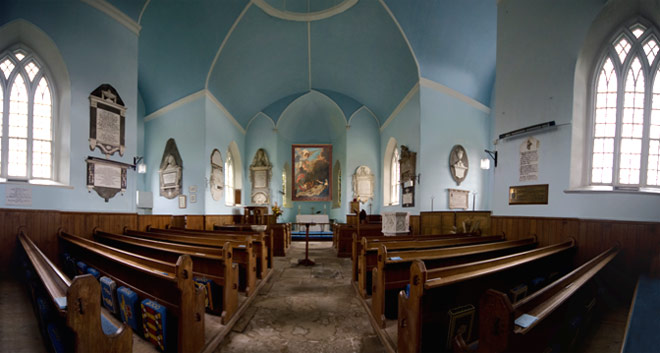ST PETER & ST PAUL, TEIGNGRACE TQ12 6QP Grade 2*
Recently included in Todd Gray’s “Devon’s Fifty Best Churches”, St. Peter and St. Paul, Teigngrace is of some significance as a Georgian church designed in a style of Strawberry Hill Gothic. The external structure that you see now is very much as it would have appeared to the Templer family at the dedication service in March 1788. Originally the church was surrounded by fields, with a pathway to the Schoolroom that was built in 1873. Over the years the village has grown and the church is now surrounded by houses. However, it still has a feel of seclusion about it, sheltered by the drive from the road and the yew in front
Originally the church was part of Stover estate, serving the village, workers on the estate and, in time, workers on the canal built by James Templer.
The earliest definite record of a church at Teigngrace dates back to 1350, but by the late 18th century it was in a poor state of repair.
The estate was purchased in 1765 by James Templer, who subsequently built Stover Lodge. He died in 1782, his wife Mary in 1784, and their three sons, James, George & John rebuilt the parish church in 1787 dedicating it in memory of their parents. The Rev. John Templer was the first Rector of the new church. The first service in the new church was held on Sunday 30th March 1788. The 220th anniversary of this dedication was held in 2008.

The Templer family is commemorated by a number of wonderful memorials.
Pevsner (1952) notes that the monuments are “both interesting and varied. They have eloquent inscriptions, but are not of excessive size. The earliest are two wall-mounted monuments flanking the chancel arch, to James Templer †1782 and his wife, Mary †1784, the first with a mourning figure at an urn, in a roundel, the second with a similar theme in a lunette at the top.—Charles Templer †1786 has a delicate shipwreck relief; Captain William Templer †1805 and his brother, both also drowned at sea, have only the signed tablet, a fat weeping angel by an urn above a Gothic fan coving, by Coade and Sealy.—The Nelson memorial, of 1805, is also of Coade stone. It has the unusual form of a figure of Fame above a globe, inscribed “slain in battle”.—James Templer †1813 has another Coade monument: a female figure reclining on an urn, a standard type.—other simpler tablets include two naval associates, Cornwallis, Viscount Hawarden † 1803 and Captain Richard Dalling Dunn †1813 , both with chaste urns, and one to the Rev. John Templer † 1832 (the first of the two Templer rectors) with draped urn on sarcophagus.”
The picture of interest in the church is the large Pieta used as an Altar piece. This seems to have been in position since the church was rebuilt. Previously it has been attributed to James Barry, the Irish artist, and some sources have said it is a copy of Van Dyck’s Pieta found in the Antwerp museum. The first attribution dates to the publication of Lyson’s Magnus Brittanica in 1822, only 35 years after the rebuilding. The states that the painting is “ a painting of Our lady of Pity, by Barry”. No mention is made of it being a copy, and indeed, if you look at Van Dyck’s work it is completely different.
The organ was installed in the tower with the rebuilding of the church and is one of only two in the country in it’s very nearly original condition. It is attributed by the West Country Organ database to James Davis, with additions by George Hawkins in 1885. Its unique feature is its original “nag’s head shutter”.
